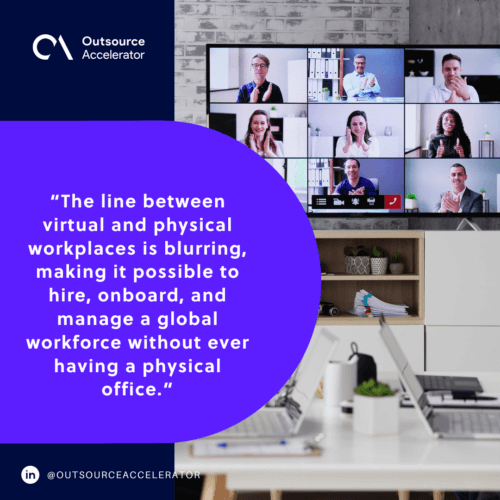How technology has made global talent more accessible

This article is a submission by Globaltize. Globaltize is a boutique staffing agency established by seasoned entrepreneurs who have leveraged global talent to grow their businesses. They provide comprehensive staffing solutions, delivering tailored, cost-effective global talent.
Accessing global talent used to feel like chasing a mirage: visible and enticing but just out of reach. For most companies, especially smaller ones, building overseas teams was a luxury only the giants could afford.
Today, however, thanks to technology, everyone has a real shot at tapping into this talent pool without spending millions on overseas offices or complex local setups.
With tech’s supercharged evolution, the way we hire globally has transformed in ways no one could have anticipated just a decade ago. Here’s a look at how this shift is breaking down barriers, opening up world-class talent, and offering more than just cost savings.
The big barriers of the past
Not too long ago, accessing global talent was a major headache. Companies had to navigate layers of bureaucracy, including:
- Getting the right permits
- Hiring legal teams to decipher local laws
- Pouring money into setting up physical offices and infrastructure abroad
And that wasn’t even the end of it.
Once the office was up, there were the operational details to manage: dealing with currency exchanges, figuring out payroll compliance, and all the administrative nightmares that came with it.
For small and medium businesses (SMBs), these costs were a deal-breaker.
Hiring globally was a big-company game. Unless you were a tech giant or multinational corporation, your chances of reaching international talent were limited to hiring the occasional remote contractor and hoping things went smoothly.
This was especially frustrating because the demand for specialized skills wasn’t bound by borders—businesses simply couldn’t get to the right people.

The game-changing remote tech revolution
Then came the boom of remote work technology, which changed everything. Tools like Zoom, Microsoft Teams, and cloud storage have turned the old hiring model on its head.
Now, teams can collaborate across countries as if they’re just a few desks away.
But it’s not just about having a Zoom account or Slack workspace. These tools allow for real-time connection, project alignment, and workflow sharing that brings global teams into sync like never before.
Even more, it’s the seamless integration of multiple technologies.
Imagine onboarding new hires, managing projects, and running payroll across countries without setting foot in a local office. With cloud-based systems and automated processes, the infrastructure that used to be a massive overhead expense is now available at a fraction of the cost.
Making the world your hiring pool
Here’s the real shift: today, if you need talent in a particular niche or expertise, you’re not limited to your own backyard.
Let’s say you’re a startup needing a specialized developer or a mid-sized firm looking for customer support in multiple languages. By hiring globally, you open yourself to talent from anywhere in the world that meets your exact criteria without compromise.
And it’s not just about filling skill gaps. Global hiring means you get to work with people who bring unique perspectives and fresh ideas.
Diverse backgrounds can spark innovative solutions, broaden cultural insights, and help companies adapt more quickly to different markets. A global team doesn’t just add skills; it adds dimension and adaptability to a company’s operations.
Beyond cost: What a global talent brings to the table
While the financial aspect of global hiring is undeniably attractive, there’s more to it than just saving money. Sure, wages for highly skilled professionals in certain regions might be lower than in North America or Europe, but global hiring is about creating a workforce that’s truly dynamic.
Take, for example, time zones. Having a team across different time zones can mean your business is essentially working around the clock.
This “follow-the-sun” model, once used mostly by customer support teams, can now apply to all departments.
Design teams in Asia can collaborate with project managers in Europe and developers in North America, so progress never has to stall.
Real ROI: How hiring global talent actually pays off
When it comes to global hiring, it’s not just the initial cost that matters.
The return on investment (ROI) can be significant over time, as global talent strategies reduce turnover and increase retention. Think about it—global hiring widens the talent pool and helps find the right fit for a role more quickly.

When employees are better suited for their roles, they tend to stay longer, cutting down on replacement costs.
Moreover, tapping into international markets means your business can become more adaptable and better prepared for expansion.
With a global team, companies gain firsthand knowledge of international markets and cultures, which can be a huge asset when looking to expand or tailor services to new regions.
The insights from a diverse team can lead to products that resonate more deeply with a broader audience, ultimately impacting the bottom line positively.
If you’re curious about the potential savings and ROI of hiring globally, check out Globaltize’s Payroll Savings Calculator. It’s a quick way to see what a global team might save your business beyond just the salaries.
The future of a borderless workforce
Global hiring is still evolving, and it will only become more accessible and integrated with the latest technologies.
Artificial intelligence and machine learning are already starting to play a role in the recruitment process. These technologies help companies identify top talent across borders with improved accuracy and speed, making the hiring experience smoother and more efficient.
Additionally, virtual onboarding tools are making it easier for remote employees to feel connected from day one.
Companies are beginning to create virtual office spaces that mimic real offices, fostering a sense of camaraderie and teamwork that transcends physical distance.
The line between virtual and physical workplaces is blurring, making it possible to hire, onboard, and manage a global workforce without ever having a physical office.
In the future, we’re likely to see even more innovative tools that will make remote and global hiring seamless.

Virtual reality (VR) and augmented reality (AR) could soon allow us to create immersive onboarding experiences, bringing teams together in a virtual space where they can meet, interact, and train in real-time.
The idea of a truly borderless workforce is no longer a dream; it’s an emerging reality.
As companies lean into this new era, those that embrace global hiring are poised to be more resilient, more adaptable, and far more prepared for the challenges of the modern business landscape.
Technology has made global talent accessible, and it’s now up to businesses to leverage this opportunity to its fullest potential.







 Independent
Independent




